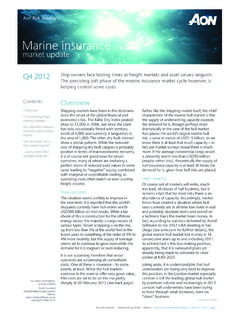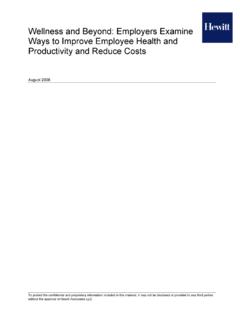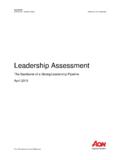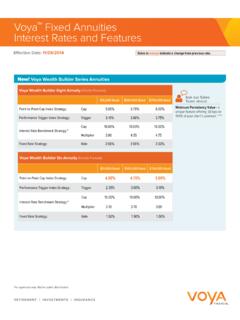Transcription of IRS Issues Final Hybrid Plan Transition Regulations - Risk
1 Aon Hewitt Consulting | Retirement Risk. Reinsurance. Human Resources. IRS Issues Final Hybrid plan Transition Regulations December 2015 On November 13, 2015, the Internal Revenue Service (IRS) issued Final Transition Regulations regarding permissible interest crediting rates for cash balance and other statutory Hybrid defined benefit plans. These Regulations delay most, but not all, of the required amendments for cash balance and other Hybrid plans under the Pension Protection Act of 2006 (PPA). The 2015 Final Regulations similarly delay the effective date of the market rate of return Transition rules and certain other rules of the Final Hybrid plan Regulations previously issued in 2010 and 2014 (unless an earlier date is elected by the taxpayer). This delay continues until the day immediately prior to the first day of the first plan year beginning on or after January 1, 2017 ( , December 31, 2016, for calendar year plans).
2 A later date may apply for collectively bargained plans, depending on the expiration date of the applicable collective bargaining agreement. The 2015 Final Regulations also provide some additional flexibility with regard to how a plan sponsor must change an impermissible interest crediting rate so that it complies with the market rate of return rules. The Regulations do not provide any additional guidance with respect to pension equity plans. Some Amendment Deadlines Delayed, Others Not The 2015 Final Regulations do not delay the deadline to amend plans for the three-year vesting requirement for Hybrid plans, and only delay the amendment deadline for the preservation of capital rule as that rule applies to multiple annuity starting dates. The deadline to eliminate whipsaw comparison calculations for prior accumulated Hybrid plan benefits, with relief from Internal Revenue Code (Code) Section 411(d)(6) anti-cutback requirements, had previously expired the last day of the first plan year beginning after December 31, 2008 (2010 for governmental plans).
3 The Regulations delay certain market rate of return, interest crediting, and related rules, as set forth in previously issued Final and proposed Hybrid plan Regulations . In particular, the provisions discussed below, and any required plan amendments with respect to these provisions, are delayed. These provisions are generally presented in the order in which they appear in the Regulations . Accumulated percentage of Final average compensation as highest average A benefit formula expressed as the current value of an accumulated percentage of a participant s Final average compensation may be based on the participant s highest average compensation rather than Final average compensation. An earlier effective date for this provision may be elected by the taxpayer. Lump-sum distribution must equal accumulated benefit The distribution of a single-sum payment under a lump-sum-based benefit formula must equal the accumulated benefit under that formula, except to the extent the single-sum payment is greater to satisfy the anti-cutback requirements of Code Section 411(d)(6).
4 As a result, a formula that determines the single-sum payment as the present value of the annuity payable at normal retirement age cannot be considered a lump-sum-based benefit formula. Also, a formula that determines the single-sum payment as the greater of the accumulated benefit or the present value of the normal retirement benefit ( , a whipsaw calculation) cannot be considered a lump-sum- Aon Hewitt Consulting | Retirement IRS Issues Final Hybrid plan Transition Regulations 2 based benefit formula except to the extent the continued application of the whipsaw calculation may be required by the anti-cutback requirements of Code Section 411(d)(6). Actuarial equivalence of lump-sum-based benefit The portion of a participant s accrued benefit determined under a lump-sum-based benefit formula must be the actuarial equivalent (using reasonable actuarial assumptions) of the then-current balance of the hypothetical account or accumulated percentage of Final average compensation, as applicable, either (A) upon attainment of normal retirement age or (B) at the annuity starting date for a distribution with respect to that portion.
5 Adjustments under a formula that has an effect similar to a lump-sum-based benefit formula The right to future adjustments under a benefit formula that is not a lump-sum-based benefit formula, but has an effect similar to a lump-sum-based benefit formula, means the right to any changes in the dollar amount of benefits over time, regardless of whether the adjustments are denominated as interest credits. Variable annuity benefit formula referenced index The rate of return on plan assets (or specified market index) by reference to which a variable annuity benefit formula adjusts must be the rate of return on plan assets or a subset of plan assets, the rate of return on an annuity contract issued by an insurance company licensed under state law (which includes the rate of return on the market index specified under such contract), or the rate of return on a regulated investment company that is reasonably expected to be not significantly more volatile than the broad equities market or a similarly broad international equities market.
6 An earlier effective date for this provision may be elected by the taxpayer. Suspension of benefits notice or an actuarial increase A lump-sum-based benefit formula must provide either a suspension of benefits notice or an actuarial increase with respect to a participant with an annuity starting date after normal retirement age, if the participant s hypothetical account or accumulated percentage of Final average compensation is not increased sufficiently to satisfy the nonforfeiture requirements of Code Section 411(a)(2).This also includes the related rules regarding optional forms that are actuarially equivalent or subsidized and proportionate application. Age discrimination safe harbor for cash balance and pension equity plans A participant s current balance of a hypothetical account or accumulated percentage of Final average compensation can be considered a safe harbor formula measure for purposes of the PPA age discrimination safe harbor only if the benefit formula is a lump-sum-based benefit formula.
7 This requirement also includes the related rules permitting certain subsidized benefits to be disregarded; both for lump-sum-based benefit formulas and indexed benefit formulas. Retention of fixed annual rate when changing to third segment rate A fixed annual floor used in combination with an interest crediting rate based on a permitted government bond rate, short or midterm corporate bond rate, or cost-of-living index, must be retained when the interest crediting rate is changed to the third corporate bond segment rate for all future interest credits under a Hybrid plan . interest crediting rates that do not exceed a market rate of return The Regulations provide an exclusive list of the specific interest crediting rates that are deemed not to exceed a market rate of return. Aon Hewitt Consulting | Retirement IRS Issues Final Hybrid plan Transition Regulations 3 interest crediting when there are increases or decreases in the accumulated benefit Specific rules for interest crediting apply when there are debits or credits to a participant s hypothetical account or accumulated percentage of Final average compensation during an interest crediting period.
8 Rounding of interest crediting rate An annual interest crediting rate may be rounded to the nearest multiple of 25 basis points or a smaller rounding interval. If a plan provides for interest crediting more frequently than annually, then the rounding interval must not exceed a pro rata portion of 25 basis points (but a plan is permitted to round to the nearest basis point regardless of the length of the interest crediting period). Note that this is a new provision which was added in the 2015 Final Regulations , and which slightly expands the list of permissible interest crediting rates from the 2014 Final Regulations . Two or more different interest crediting rates When two or more different interest crediting rates are applied, specific rules must be met in order for the resulting interest crediting rate to be deemed not to exceed a market rate of return.
9 Preservation of capital and multiple annuity starting dates Specific requirements must be satisfied when applying the preservation of capital rule to multiple annuity starting dates. Fixed rate of interest A fixed annual interest crediting rate must not exceed 6% in order to be deemed not in excess of a market rate of return. Return on subset of plan assets, registered investment company, or combination rates of return Specific requirements must be satisfied when a plan provides an interest crediting rate based on a subset of plan assets, a regulated investment company (mutual fund), or a combination of rates of return. plan termination Specific rules apply to the determination of interest crediting rates upon termination of a plan . Coordination of anti-cutback and market rate of return rules Specific rules must be followed to coordinate the anti-cutback rules of Code Section 411(d)(6) and the market rate of return limitation, including changing the lookback month and stability period used to determine interest credits or in the event a regulated investment company upon which interest credits are based ceases to exist.
10 Actuarial increase not in excess of market rate of return A plan is not treated as providing an effective interest crediting rate in excess of a market rate of return solely because it provides an (actuarial) increase in a participant s accumulated benefit after normal retirement age, so that the participant s benefit is equal to the greater of (A) the benefit based on the accumulated benefit determined using an interest crediting rate that is not in excess of a market rate of return, and (B) the benefit that satisfies the nonforfeiture requirements of Code Section 411(a)(2). Aon Hewitt Consulting | Retirement IRS Issues Final Hybrid plan Transition Regulations 4 Additional Transition Rules for Noncompliant interest Crediting rates The 2015 Final Regulations permit a plan with a noncompliant interest crediting rate to be amended with respect to benefits that have already accrued, such that its interest crediting rate will comply with the market rate of return rules, but only with respect to interest credits that are credited for interest crediting periods beginning on or after the later of the effective date of the amendment or the date the amendment is adopted.















